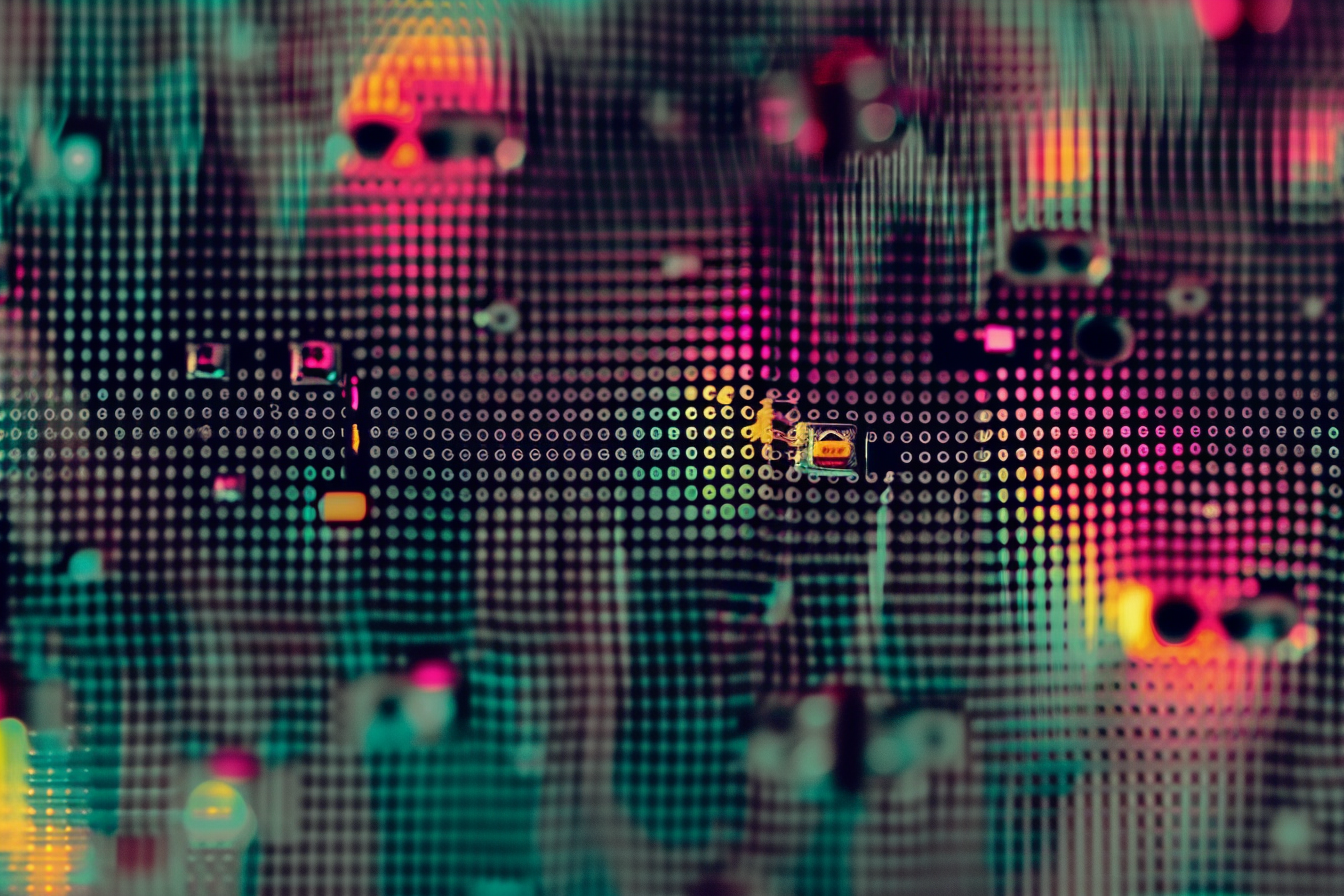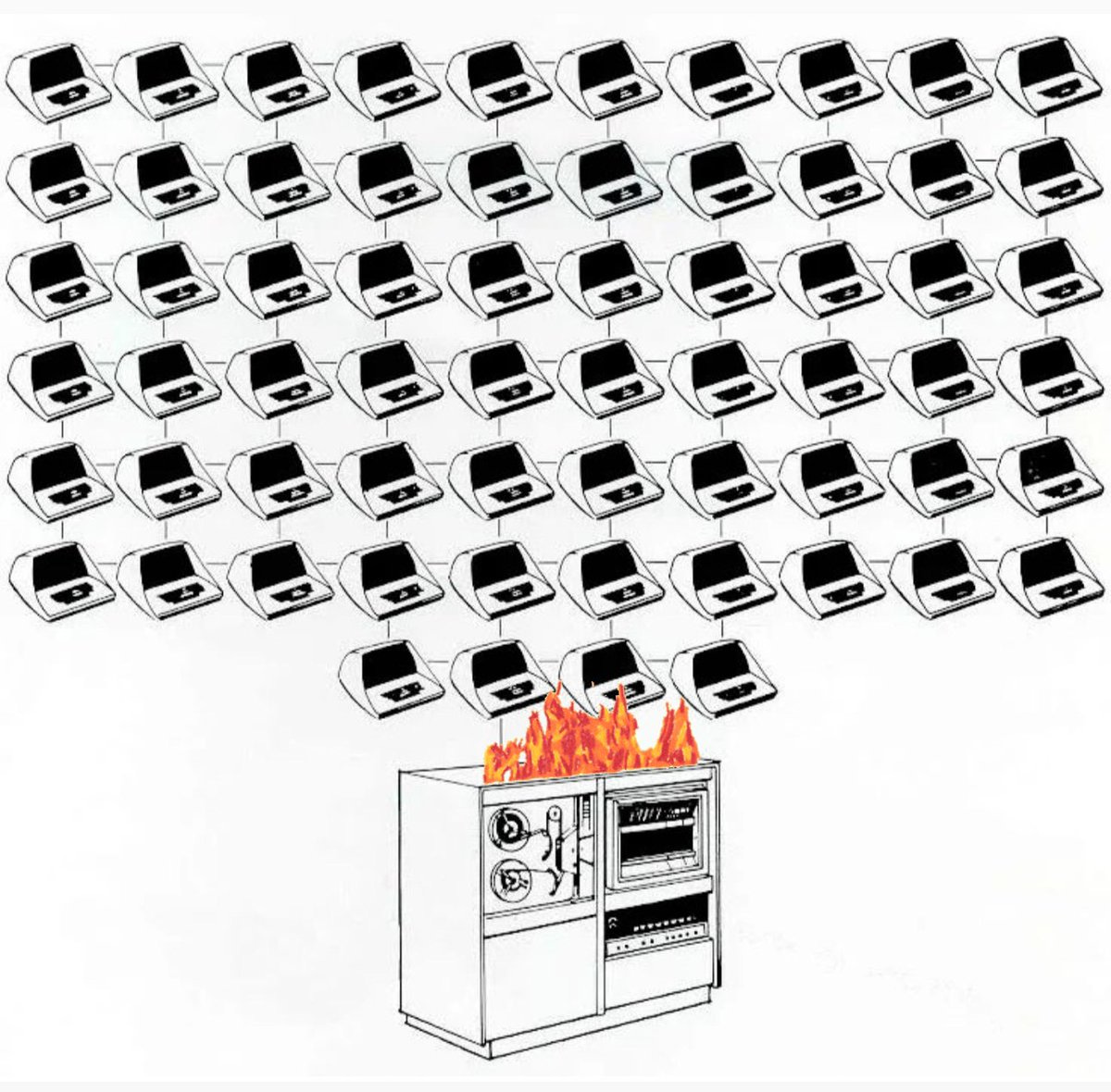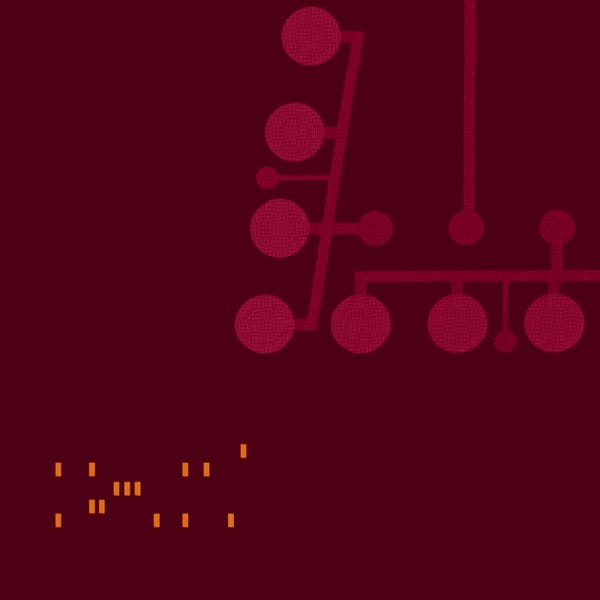Gaussian Pop: 14 Theses
A reluctant manifesto for the contemporary moment in visual art, sound and text.

Sometime, maybe in 2025, you’re going to want to listen to something new. You may have worn out the last record by a favorite band, or maybe that band broke up too soon. You have a sense of what you liked about that band: the way it blended motorik beats and flamenco guitars, a hint of harsh electronics that always resolved back to something floaty, or a groove you could get lost in.
Sometime in 2025 you’ll be asked to describe what you want to listen to, and an app will give you some suggestions, but you’ll know them all, have worn them all out. You’ll notice something new: the search bar will pop up and ask if you’d like a JAM that fit that description. Curious, you’ll click yes, the window will go away, and new music will start to play. You’ll dig it. It’ll sound like exactly what you wanted.
Three songs in you’ll be really excited by all this cool music it’s found for you. Five songs in and you’ll hit skip. You’ll skip ahead three songs and realize they all sound kind of the same. At that point you might realize that you haven’t been listening to bands, you’ve been listening to music made by an AI model prompted by your search.
You’ll realize that’s just fine, actually, and you have other stuff to do. You’ll let the thing run while you’re distracted with work or a run, thinking about other stuff, paying half attention to what’s on there. You’ll never really notice any of the music at all: it will satisfy you just enough not to skip it. So you won’t.
2025 isn’t that far off. These tools are here, even if they aren’t yet integrated into your everyday music apps.. Tools such as Suno and Udio are glitchy, but they are offering Spotify-like interfaces where users can describe what they want to hear, which is assembled for them through a blend of diffusion and transformer-based models. If you don’t know what you want to hear — if even that is too much effort in the 21st century — you can generate a random description.
I’ve been working with AI music for years now. This is something different. It’s not a tool for musicians, but a tool for listeners designed to reduce the cost of music streaming services. Spotify had long been suspected — with sizeable evidence — of padding its most popular playlists with in-house bands it recorded themselves, saving money on royalties. Musicians have never been what streaming music was about: the demand for compensation has always throttled profits. The more you can steer users away from artists and toward some kind of ambient vapor, the more money was in the business model.
Listen long enough, and what emerges is a sonification of algorithmic culture: what firsts seems limitless quickly reveals the limits of what it can do. But this won’t last forever. What makes pop music pleasurable to the human ear is the combination of repetition and unpredictability: the slight shift in rhythm, then the return; the drop, the stray improvised note. AI will be able to do that pretty well, because it has been, from the beginning, a tool that navigates variety and constraint.
I want to think of this music as something else, though: Gaussian Pop. A genre, or a movement of sorts, that is distinct from the sounds made by people. Gaussian Pop sounds like music. But it’s constrained by the alienness of predicted emotions, and the synthesis of those emotions without understanding the source: imagining dancing like you don’t have a body, singing like you have never felt anything, and never will. That is Gaussian Pop.
The interesting opportunity of Gaussian Pop is what I have been thinking of as Gaussian Baroque: coming from barroco, “a flawed pearl,” one which resembles an object of desire but holds chips or uneven shapes upon closer inspection. Gaussian Baroque is not glitch, but an image or sound that with clear flaws hidden by the banality of what surrounds it within the “ideal” AI-generated image or song: the uncanniness, the extra fingers, the smudges and bumps. My theory of Gaussian Baroque is that it can elevate sections of these images and sonic landscapes as “spikes” into the art of standard deviation. It can be dance music with backing tracks that degrade into solid drones in unexpected ways; maybe folk songs with lyrics that reject your immersion in the illusion of being sung to.
What follows is a manifesto of sorts, or a collection of ideas about Gaussian Pop, that aims to think from within the logic of these systems. It is a work in progress, assembled on my now-daily London walks from Hackney Wick to Spitalfields, trying to understand the music I was making with these tools. The text is below. The buttons link to some samples of my personal playlist. (You likely have no interest in doing that and that is OK).
Gaussian Pop
14 Theses on the Contemporary Moment in Visual Art, Sound and Text
1. Gaussian Pop emerges from the era of scrolling: what would have been idle time, which should spawn a restlessness in search of creative production or cheap thrills, has become pacified into consuming an interface.
2. Gaussian Pop alienates us from our own preferences. When we scroll, brief moments of attention interrupt streaks of inattention, shaped by an algorithm responding to our previous engagements. We seek stochastic pleasures from the scroll, moments when our attention and preferences align.
3. Gaussian Pop is the generated music, or image, or text which satisfies the urge to scroll: it is tailored to inattentiveness.
4. Gaussian Pop lures us in but denies full immersion. It lacks detail, or contains strange tonalities, upon inspection: but this music was never meant to be inspected. Just as an AI generated image holds our attention for 7 seconds, and AI generated text designed to be skimmed, an AI generated song is only meant to be heard once.
5. Gaussian Pop sounds like music. Just as the AI image has a passing resemblance to photographs. Regardless of detail, the way these songs are made — regardless of quality or complexity — will never allow them to transcend the a mere resemblance.
6. Gaussian Pop can produce something profound just as the sublime can sometimes be achieved through coincidence. These coincidences will be pointed to as evidence of a capacity for it to transcend these limits: it isn’t.
7. Gaussian Pop flourishes in the space between our eyes or ears and the screen, where attention is slightly disembodied — loosely suspended to allow our attention mechanisms to be augmented by the algorithm. Gaussian Pop thrives in inattentiveness.
8. Gaussian Pop doesn’t have to be subtle or unobtrusive to be ignorable. It occupies the mind for exactly as long as idleness affords before seeking out something else. Likewise, Gaussian Pop art resembles the punctum of an image, but it’s a finger prick that doesn’t bruise us, a memory that dissolves with the next thought.
9. Gaussian Pop satisfies a demand for fleeting engagement. It is designed to dissolve seamlessly into the “next.” Being an extrapolation from latent space, Gaussian Pop boldly hovers in-between spaces: it is the standard deviation of culture, comfortably camouflaged within the consensus definitions we use to prompt it. Gaussian Pop is immediately outdated: it relies on the past to predict the next 7 seconds of culture.
10. Gaussian Pop is a highly democratized art form, an ultimate but politically eviscerated evolution of Fluxus music. It’s produced by consumers, who consume the joy of automated production. Consumption and production are fused into the same vehicle.
11. Gaussian Pop artists document the outcome of their idleness to share with others in the memetic sense of “sharing” a social media post: it is self-expression through curation. Few Gaussian Pop songs resonate beyond the listener who generated it: that follows a logic of customizable isolation that permeates the Big Data era.
12. Gaussian Pop is the literal aestheticization of Big Data and social media metrics, a response to algorithmic culture curated by algorithmic systems for algorithmic systems.
13. Gaussian Pop is always infused with a mourning for the absence of what it has erased: ghosts of those whose emotions have been trapped within the confines of a standard deviation.
14. Gaussian Grotesque is a response to Gaussian Pop: not a sincere enthusiasm for the mechanisms but a texturing of its mediocrity, a testing of the limits of Gaussian distribution, a bundling of mode collapse and glitches into banality as to become invisible.
End of the Night, End of the DJ
There’s no hiding the labor argument behind AI tools: audio systems will lead to less jobs for musicians, the vast majority of whom are in the midst of precarious careers. Those who can afford to eat without making commercial pop music are often working for those who do, or strive to: audio engineers, commercial jingles, film and TV scores. DJs, also a precarious career choice, have been under attack by automation since the rise of shuffle mode and music libraries.
That systems like Suno and Udio are trained on data with unclear provenance makes it all the worse. Every album an artist makes is now curated data. Every album release party was cheerleading the datasets of our own demise.
Meanwhile, AI images are embraced and promoted by Facebook’s algorithms because similar algorithms determined the value of images in aesthetic datasets to begin with.
But my emotional response transcends economic concerns. There is just something sad permeating everything I generate. The sounds Suno produces suggests the erosion of a certain kind of artwork which called for attention and immersion in order to be appreciated. It really does seem as if the tech industry is only accelerating the pace of information to overwhelm the human capacity to take it in.
This is not music to be listened to or appreciated it. It is music meant to be a result of seeking dopamine spikes, served in a way that asks you to hit another button.
But it also seems like it can’t be shared, that it is designed to be listened to in isolation. Algorithms were meant to sort the sea of information to give us what we needed, or wanted, and now the same data infrastructures are used to produce even more personalized information just as our tools for navigating it are degrading. (Run a Google search and see how much AI generated content it gives you).
The shared experience of music will not disappear, of course, but it’s sad to hear a sound that seems to devalue it. Of course there will be a lamentation for the human-scaled world. The tech industry and those who champion it seem to revel in the humiliation of human limits, siding with the machines the way cowards have always clung to the orbits of power. Far more confusing to me are those who mean well and define all of this as nothing but progress.
Every technology creates a space for mourning the world that existed before it, and mourning that world is appropriate. Large scale interventions into human culture are traumatic breaks with what anchor and orient us.
My impulse is to confound this erasure. I know a certain kind of artist chases the shiny new regime and portrays it as revolutionary, situates themselves in the future and chases it, hoping to influence the new arrangement.
But I also am heartened by the culture that exists and persists offline. This culture, though, seems increasingly inaccessible. You can see it in New York City or Dublin or London. You find it less in smaller towns where the internet competes with cable television for attention. This is the kind of isolation that breeds AI extremism. To say “I don’t need other people” — which is what AI music says, whether it is to make it or dance to it, it is music for an individual, not individuals. That implies a lack of people around us to begin with. It’s a lonely kind of music.
To see artists and experimenters coming together to make new sounds that exist outside of technology is refreshing, and it does exist. But AI is meant to fill the void of this online world, where attention is always being sorted toward profitability. We used to have blogwave! Music shared by people who thought the people who read them would dig it. The DJ used to have some clout. Now they have a prompt.
They’ll be in the world, but I don’t think they’ll be online, or in our apps. I fear that AI will run the web, and we’ll create a culture that encourages isolation. This is always my fear with AI. That the web that had created for communities of artists simply won’t be available to us. AI will make it 1988. Art and creative agency won’t disappear, they just won’t be as visible.
ARRG! “Models for Making Distance”
Zine Deadline: April 15!

Two days left to join the network: send your creative algorithmic interventions and manifestos to the ARRG! Zine, “Models for Making Distance!”
Models For Making Distance is a print zine gathering a multiplicity of manifestos, writing and instructions for art that confounds, confuses and misuses algorithmic systems for the pleasure of human observers or actors. It is a playful but earnest bid for placing distance between ourselves and the tools designed to measure us. Details for submissions, and instructions to submit, are below!
Things I am Doing This Month
Now with sparse details!
April-May 3: Flickr Foundation, London, UK
I have my Flickr Foundation Residency ongoing and would love to connect with anyone thinking about art, memory, archives, and AI. Reach out!
April 16: Bristol, UK: Watershed Pervasive Media Studio
I will be doing a small presentation that is part AI literacy, part artist talk for residents of the Pervasive Media Studio at Watershed. This talk is limited to residents at Watershed Pervasive Media Studio, but if you email me maybe we can sort something out.
April 16: Online: Digital Curation in the Shadow of AI, with Jon Ippolito and Christiane Paul
I might see you at this online event with two of the world’s best digital curators, from the Guggenheim and the Whitney. Check it out!
April 25: Cambridge, UK: University of Cambridge
I will be speaking as part of a Cambridge Digital Heritage Open Seminar series, with Andrea Wallace. Time and Location TBD. I will be in Cambridge all week - same offer to anyone who would like to discuss archives, memory, data and/or AI.
April 19, 21: Stuttgart (Sindelfingen) Germany, Gallerie Stadt Sindelfingen
For the “Decoding the Black Box” exhibition at Gallerie Stadt Sindelfingen, which is showing Flowers Blooming Backward Into Noise and Sarah Palin Forever, I’ll be giving an artist talk, “The Inner Life of AI Images,” at 7pm on the 19. On the 21st, tentatively, I’ll be part of a daylong workshop showing new work linked to “The Taming of Chance,” a project by Olsen presented alongside new works by Femke Herregraven, the !Mediengruppe Bitnik, Evan Roth & myself, who will all be there in person.





